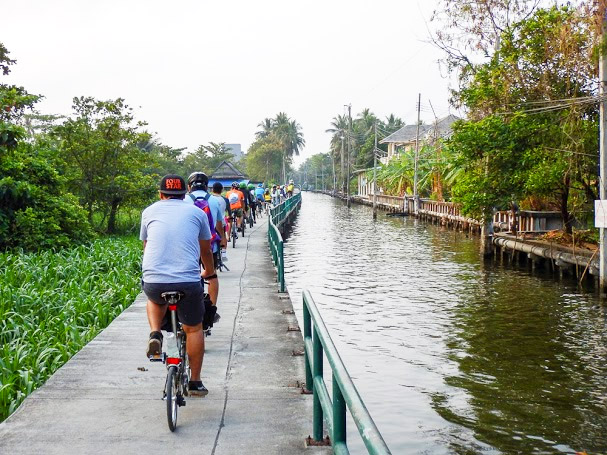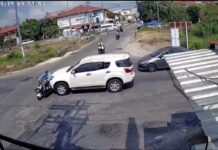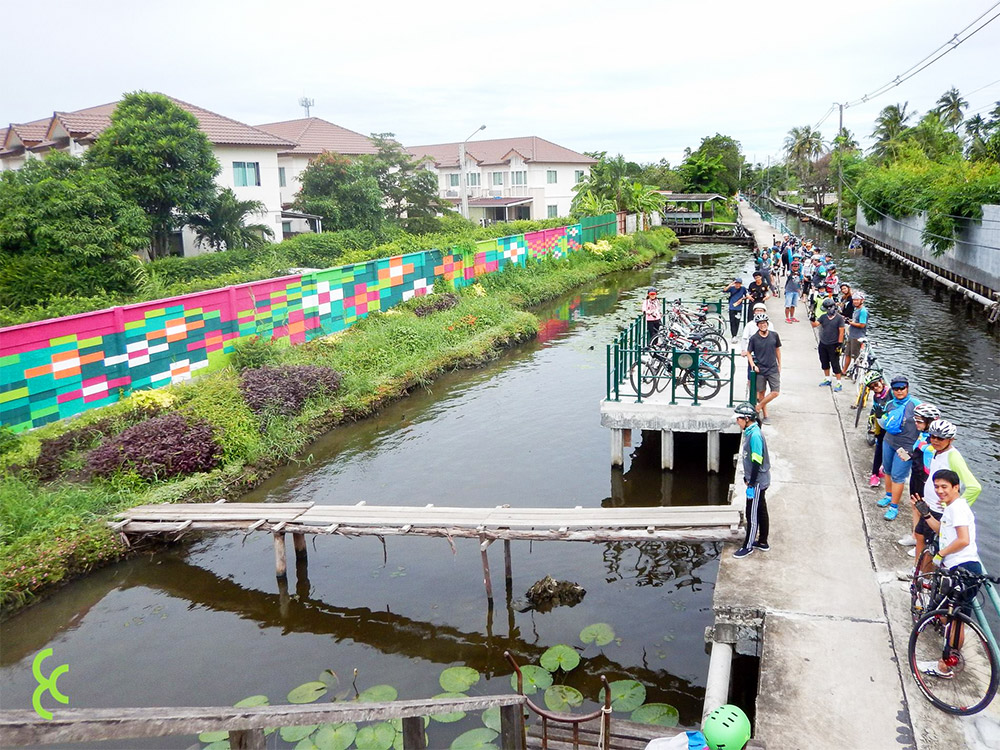Walking in Bangkok is awful. Driving isn’t much better, but at least it avoids sidewalks that are dirty, broken, obstacle courses. Driving also means less direct exposure to air that is getting more polluted – partly because of all that driving.
How to break this feedback loop? What if, instead of taking a motorbike or taxi to travel a kilometer or two, one could walk or cycle through a green corridor of trees and flowing water? What may sound like unlikely fantasy can be achieved by returning to Bangkok’s past to restore canals neglected or buried under concrete to pave the way for the automobile age.
That’s the idea behind a pilot project to revive the extensive network of khlong, or canals, for which the capital was once called “Venice of the East.” By restoring these waterways and plugging them into the transportation grid, the Cycling-Canal-Community Project sees a way to help end the transportation nightmare and reverse Bangkok’s slide into unliveable, smoggy dystopia.
“Bangkok was built on river and canal networks,” said Kanjanee Budhimedhee, who heads the project. “Canals were a unique trait of Bangkok, but we ditched them when we developed roads. Today, canals have become a problem. They trap waste and create a foul smell.”

The goal is to start with a car-free route along approximately 10 kilometers of canal in southwest Bangkok, between the Thung Khru and Chom Thong districts. If successful, the passage would reach roughly 10,000 people in about 10 communities.
“These kind of corridors by canals actually exist across Bangkok… but they are not connected,” she said.
If the canal corridors can be linked together and act as feeders into the city’s mass transportation system – boats, buses and trains – Kanjanee believes “it will become a huge alternative … and a real option for people” who do not want to rely on cars.
It would also mean more transit options that are safe and efficient while encouraging people to walk, bike and ultimately reduce the number of cars on the street. Restoring them would also help with that fetid khlong odor.
It’s an idea that’s proven successful in cities around the world, where neglected rivers and canals have been “daylighted” and restored to increase quality of life – and property values.
A decade ago, Seoul turned its extremely polluted Cheonggyecheon stream into a verdant wonder that’s brought nature to residents in the heart of the concrete jungle. It’s also reduced temperature, pollution, and seen animal life flourish.
It’s a sight Kanjanee hopes to create through her initiative. After being approved and funded in 2016, the team behind it is still negotiating with local government and community leaders about design and construction.
“We’ve tried to push it in one or two districts with Bangkok’s administration many times, but there are conflicts, such as some routes that we picked may not be welcomed by the people who live by the canals,” Kanjanee said. “However, we told the administration that if they agree on this, we can go and talk to every household there.”
Bangkok’s old water-based transport network “wasn’t prepared for streets and footpaths” and today “we can’t find any more space for roadways,” said Yossapon Boonsom, a prominent landscape architect who’s worked in urban design for over a decade.
Streets cover only 7 percent of land in Bangkok, while most cities average about 20 percent to 25 percent, according to a study by the Urban Design and Development Center of Chulalongkorn University.
In his opinion, the capital today discourages people from walking and using public transportation, leading many to be trapped inside cars too long.
These factors essentially “prevent us from encountering other people” and the chance to live in sync with the city, he added.
“We’ve missed opportunities to participate,” Yossapon said.
While building more roads is not a sustainable solution, reclaiming space from cars doesn’t work either. Kanjanee said that in her 10 years in city development, she’s found that attempts to increase pedestrian and bike zones by “seizing” spaces originally meant for cars “doesn’t work.”
Therefore, she saw a potential solution in the disregarded, out-of-sight areas along the capital’s 1,161 canals that stretch over 2,200 kilometers.
Though progress on the project has been slow, Kanjanee remains optimistic that it’s value – and low cost – will win local support.
Yossapon believes that getting people out of the car and into public spaces will lead to greater investment in shared spaces.
“If people use a lot of (public space), the government then will be obligated to keep it in good condition,” he said. “It will eventually affect the surroundings of the city, and lead it to become a better place.”












































